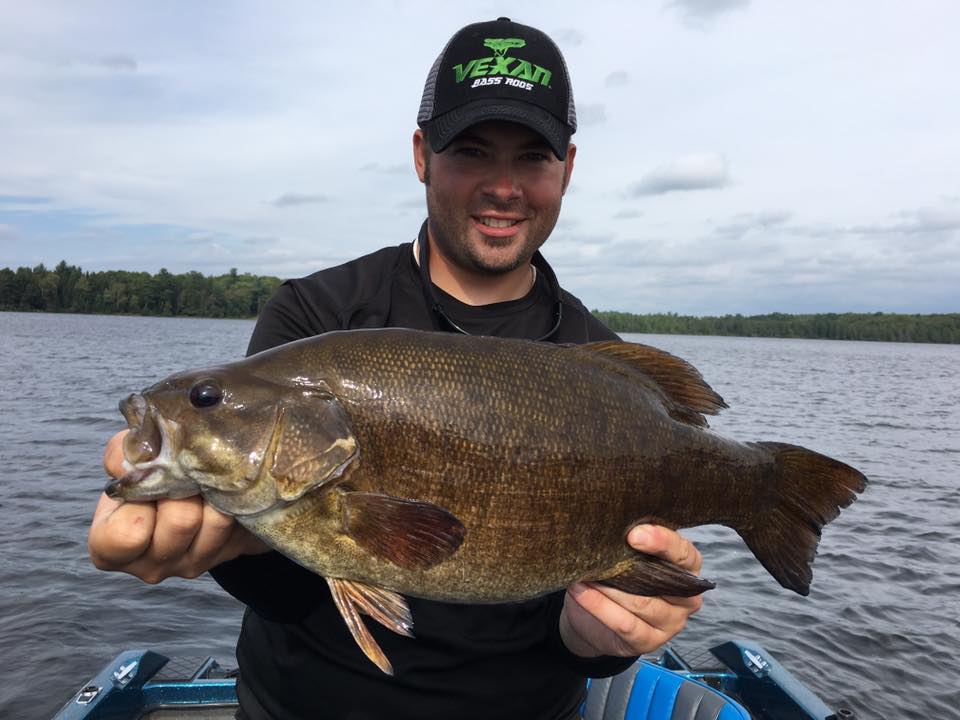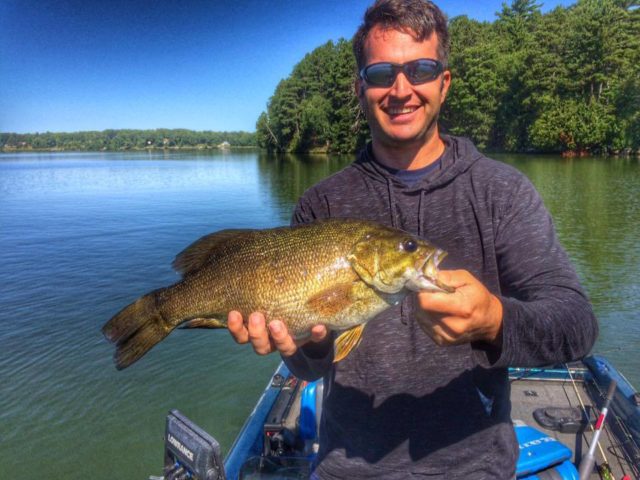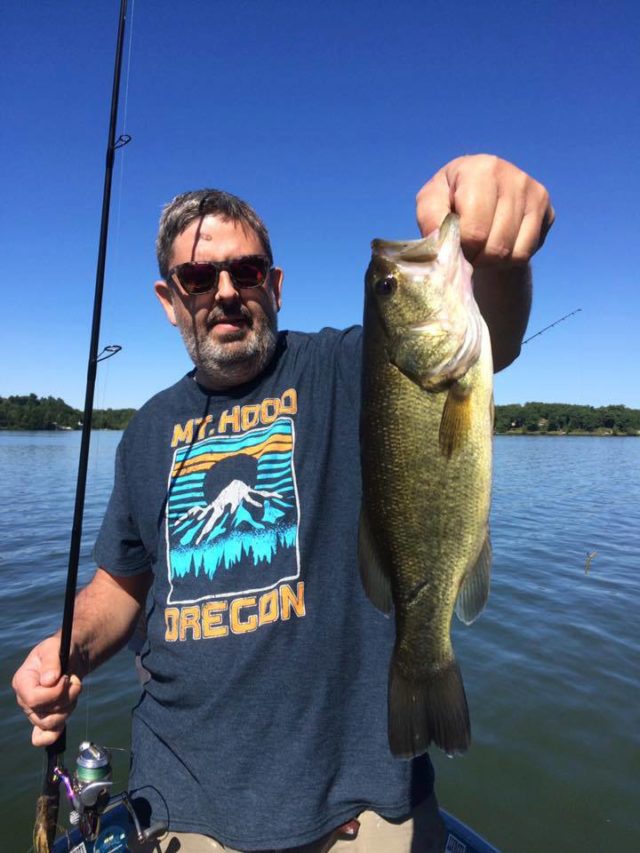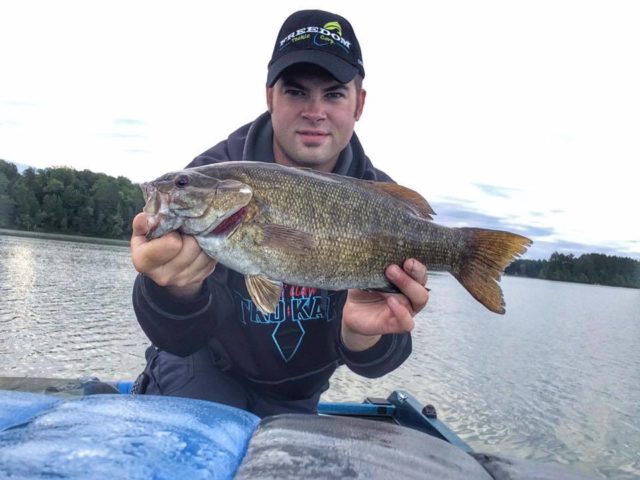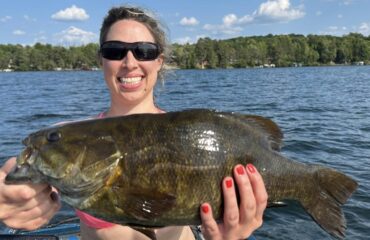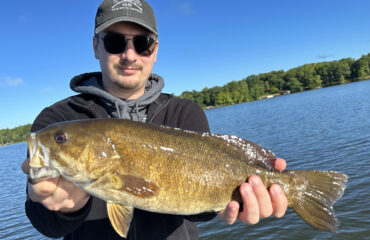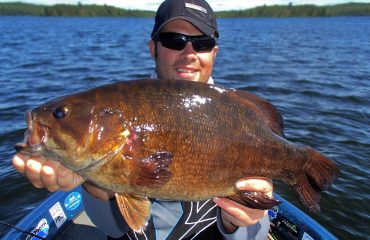Northwoods Bass Fishing Report, September 2016
September was a month of transition. Proof is in the weather forecast, on the leaves, on my Lowrance temperature gauge, and below the surface. What was an outstanding end of summer through Labor Day weekend gave way to the first phase of autumn; pre-turnover.
Bass are moving and schooling, frequenting depths of shallow for feeding, and deep for homing and sanctuary. Success has varied on a lake by lake basis, but one thing’s for certain; this time of year, the end of my bass fishing season is near. Fall doesn’t offer great fishing for numbers, but what she does give up are some big ones. In my boat, we’re chasing giant bass, looking for that best bite of the year, and catching our late-season home runs.
I had a wonderful month of largemouth and smallmouth bass fishing across the waters of Vilas and Oneida county with guests. However, the cold fronts we had early in the month made fishing difficult even though multiple 20+ fish outings were had.
In September, I also made my first trips of the season into Forest County, and always return to Minocqua impressed of their quality world-class bass fisheries. Forest County bass fishing has resulted in some of my boat’s largest ever smallmouth bass captured, which includes a 6.2 pound monster from end of September, 2015.
As the calendar transitions from summer to autumn, fish locations have been too. Right now we have both shallow water movements for feeding, and deep water movements for wintering.
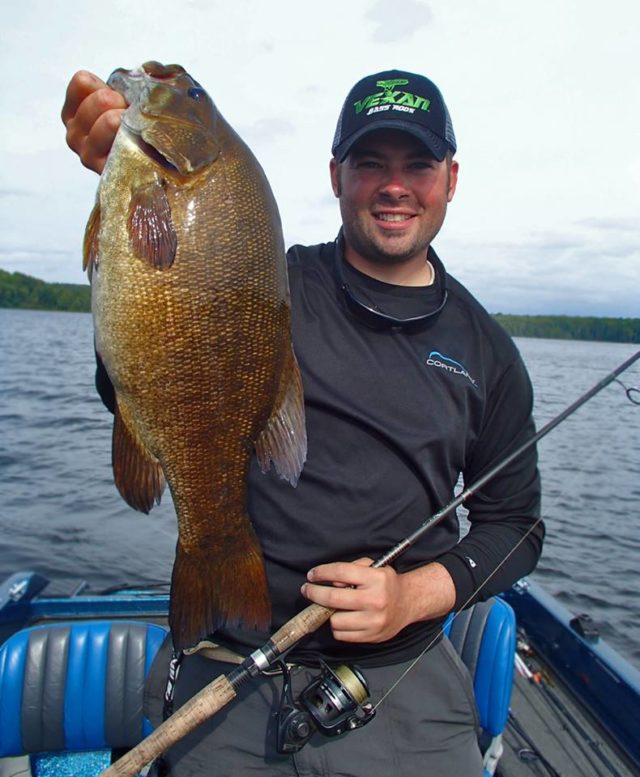
5.2 pound smallmouth bass from Vilas County, Wisconsin. This fish measured 20.75 inches, and was caught during Labor Day on a Strike King Coffee Tube.
What was a bite once dominated by rock structure and crayfish, only a few weeks ago, has now developed into a weedline and open water baitfish and preyfish bite. However, fish are still using both, and even setting up near their wintering locations, only to settle into them once turnover has completed. Thanks to the change in seasons, the first series of cooldowns are taking place, dropping 70- degree water temperatures from September 17th to the low 60’s at this writing. Water temperatures will only keep getting colder from here.
Even though fish are dispersed on many locations right now, I love the challenge and increased chances of catching giants right now.
I always look forward to this time of season as more bass will be moving into the shallows and feeding on baitfish until turnover period (55-58 deg range). A pattern I like to capitalize on for this time of season is locating migrating schools of yellow perch along the deep and still green weedlines. Usually I find this dynamic in depths from 5 to 15 feet.
These perch schools (often times massive schools) will be found in sand grass, and along the deep edges of weedlines (cabbage beds best). A lot of traveling schools of smallmouths can be located nearby along the deep edges following these perch schools, and corralling perch in the shallows. Swim jigs with my favorites being a Jonn Graham Warrior Jig catch lots of bass. Then small compact swimbaits and rip jigging with paddletail plastics such as Stankx Bait Co’s. Damzel catches tons. In addition swimming grubs rigged on an 1/8oz. Freedom Tackle Corp. Hydra ultra-light, suspending jerkbaits, flukes, lipless crankbaits, and carolina rigged minnows can all capitalize and are my favorite techniques to catch these weed-oriented smallmouths. Look for this pattern now happening on a lake nearby you. Meanwhile, largemouth bass will apply themselves to this same perch pattern as well on lakes they reside in.
As the perch pattern is happening in what remains of the green weeds, smallmouths are also setting up in areas with deep structure in preparation for late fall and winter. These fish are being located in small schools along steep breaklines, and deep offshore points and rock humps. I’ve been catching fish from these areas on deep diving crankbaits such as the Rapala DT-10, lipless crankbaits with my favorites being a Strike King KVD sexy shad, Rapala Clackin’ Rap and Rippin’ Rap, blade baits such as the Freedom Tackle Corp. Minnow, vertically jigging with flukes, and the ever-trusting drop shot rig with any minnow imitating plastic.
In these same deep water locations, you may also find a crayfish migration taking place, and there’s no better way to catch these fish than probing the depths with tube jigs and hula grubs. As water keeps getting colder, these areas will be more in play, as they are usually located in nearby proximity to wintering holes.
And in the event it’s needed as a last resort, a simple Lindy Rig with a redtail chub rigged on a circle hook can catch plenty too.
Whether seeking trophies, or looking for a challenging experience in learning new water, early autumn until fall turnover is my favorite time of year for giant bass. We have a fair number of crappy days to look forward to and deal with. But then I actually catch some of my biggest and best bass of the year during warm’ish sunny indian summer days.
END OF YEAR FALL DATES AVAILABLE:
I have September 28-29-30, and October 3 thru 9 open; all full days. I will be fishing for bass as late as October 14th if conditions allow. Please contact me by phone or e-mail if considering booking your late season trophy hunt.
As I treat the resource with respect and refuse to exploit massively schooling bass and their wintering holes during fall months, my last days of bass fishing this year will probably be after the weekend of October 8-9. This will be largely dependent on water temps, weather, and locations. Following post-turnover, usually by mid October, when water temperatures are in the low 50’s my season is all but over as I don’t enjoy catching deep water, wintering smallmouths. Neither do I like exploiting their locations and vulnerability, as these fish need better protection from meat hunters and head clubbers. This world class resource needs to be treated with respect and care so it stays this way.
Until then we’ll be on the trophy hunt for some fall giants as they transition into fall patterns and prepare to winter.
Andrew Ragas
Northwoods Bass Fishing Adventures, LLC
Licensed and Insured
Specializing in Northern Wisconsin inland bass fishing
tel: 708-256-2201
email: andrew@northwoodsbass.com
web: www.northwoodsbass.com


